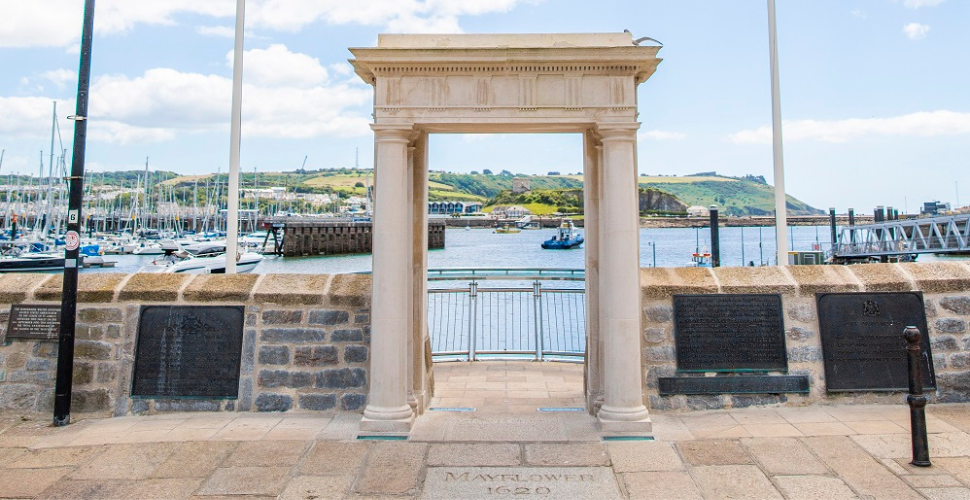Being Britain's Ocean City, and boasting a rich naval background there are plenty of maritime heritage sites in Plymouth.
This city is shaped by its maritime roots and while it continues to be the home of the largest dockyard in Western Europe, its past includes iconic figures and events that have sculpted the world we live in today.
Discover the maritime monuments on show here that continue to showcase the importance of the sea to our city.
Mayflower Steps
Among Plymouth's most iconic maritime spots, the Mayflower Steps mark the site from where the Pilgrims are believed to have set sail on the Mayflower to discover America in 1620.
Situated in the heart of The Barbican, the monument is adorned with British and American flags.
You can discover more about the fascinating journey of the Pilgrims at the Mayflower Museum which stands opposite the Steps. Spread across three floors, the museum presents an experience which showcases what life would have been like onboard the Mayflower ship.
Plymouth Naval Memorial
It is impossible to miss the enormous Naval Memorial if you visit Plymouth Hoe. Located next to the Promenade, opposite Smeaton's Tower, the memorial commemorates 7,251 sailors of the First World War and 15,933 of the Second World War who sadly lost their lives.
It is one of three Naval Memorials in the country (the other two are at Chatham and Portsmouth) and looks directly out to Plymouth Sound.
The Box
Plymouth's award-winning museum, The Box has a whole host of fascinating facts on Plymouth's maritime history within its walls. Amongst its permanent collections is the 'Port of Plymouth' Gallery which shows through art, artefacts, film and more, the relationship that Plymouth has had over the years with the sea. From wartime stories to tales of the fishing trawlers, the museum is a terrifci venue to discover the city's humbled past.
Naval Ships Statues on The Hoe
You can discover a cute nod to the Naval roots of Plymouth at West Hoe. Head to the sea wall on the South West Coast Path just off Grand Parade and you'll be greeted by model ships on the top of the wall. From submarines to aircraft carriers, there are many statues to check out by the water's edge.
Sir Francis Drake Statue
Just yards away from the Naval Memorial on The Hoe is the Sir Francis Drake statue. It is situated in front of the bowling green where legend has it that Drake was playing bowls when he heard news of the oncoming Spanish Armada on 20 July 1588. Drake, an explorer and privateer, opted to finish his game undisturbed before heading out to see where he defeated the Spanish Armada. This statue features Drake standing next to a globe which pays tribute to his well-known ability to circumnavigate the world.
Royal Citadel
With roots going back to the 17th century, the Royal Citadel is a major military establishment, which is still in use today on the east side of Plymouth Hoe.
Originally built to protect Plymouth's port from enemy invasions, the Citadel's high walls make it a major sight to see on the waterfront. The Royal Citadel remains an operational military establishment and is home to the British Army’s 29 Commando Regiment.
Drake's Island
It's impossible not to include Drake's Island on this esteemed list of maritime monuments. The Island which sits directly in the middle of Plymouth Sound National Marine Park has been at the forefront of the city for generations.
Packed with incredible historical facts, the island has been used as a fortification to defend the city in years gone by. Legend has it there is a tunnel that leads from the island underwater and back to Plymouth although this has yet to be proved. You can tour the island with Plymouth Boat Trips who offer a Drake's Island Explorer trip among their many voyages.
Mount Edgcumbe
There's more to Mount Edgcumbe Country House than stunning scenery and breathtaking gardens. The Country House and Park has its own maritime heritage sites which have been a mainstay at the park for centuries.
The Garden Battery is one of these, set on the seaside of the country park, the impressive brick structure was constructed in the 1860s as a fortification to protect the nearby Devonport Dockyard. The battery is set for renovation after Plymouth Sound National Marine Park received funding from the National Lottery Heritage Fund.
For further themed Plymouth inspiration, exclusive offers and things to do in the city, sign up to our free Visit Plymouth e-newsletter.
In partnership with GWR, Destination Plymouth’s lead travel partner
Comments
Nobody has commented on this post yet, why not send us your thoughts and be the first?


 to add an item to your Itinerary basket.
to add an item to your Itinerary basket.





